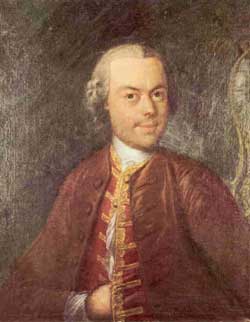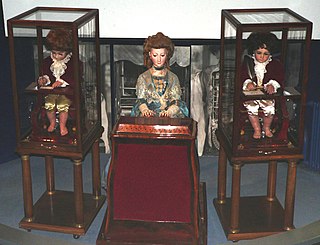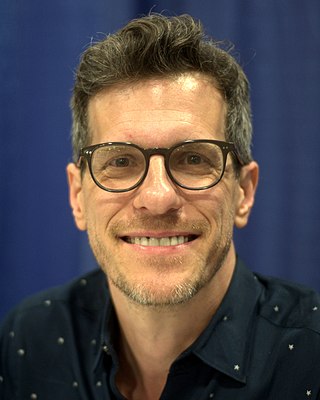
David O. Selznick was an American film producer, screenwriter and film studio executive who produced Gone with the Wind (1939) and Rebecca (1940), both of which earned him an Academy Award for Best Picture. He also won the Irving Thalberg Award at the 12th Academy Awards, Hollywood's top honor for a producer, in recognition of his shepherding Gone with the Wind through a long and troubled production and into a record-breaking blockbuster.

An automaton is a relatively self-operating machine, or control mechanism designed to automatically follow a sequence of operations, or respond to predetermined instructions. Some automata, such as bellstrikers in mechanical clocks, are designed to give the illusion to the casual observer that they are operating under their own power or will, like a mechanical robot. The term has long been commonly associated with automated puppets that resemble moving humans or animals, built to impress and/or to entertain people.

Badīʿ az-Zaman Abu l-ʿIzz ibn Ismāʿīl ibn ar-Razāz al-Jazarī was a Muslim polymath: a scholar, inventor, mechanical engineer, artisan and artist from the Artuqid Dynasty of Jazira in Mesopotamia. He is best known for writing The Book of Knowledge of Ingenious Mechanical Devices in 1206, where he described 50 mechanical devices, along with instructions on how to construct them. He is credited with the invention of the elephant clock.

Pierre Jaquet-Droz was a watchmaker of the late eighteenth century. He was born on 28 July 1721 in La Chaux-de-Fonds, in the Principality of Neuchâtel, which was then part of the Kingdom of Prussia. He lived in Paris, London, and Geneva, where he designed and built animated dolls known as automata to help his firm sell watches and mechanical caged songbirds.

Sainte-Geneviève Library is a university library of the Sorbonne-Nouvelle public liberal arts and humanities university, located at 10, place du Panthéon, across the square from the Panthéon, in the 5th arrondissement of Paris.

John David Logan is an American playwright and filmmaker. He is known for his work as a screenwriter for such films as Ridley Scott's Gladiator (2000), Martin Scorsese's The Aviator (2004) and Hugo (2011), Tim Burton's Sweeney Todd: The Demon Barber of Fleet Street (2007) and Sam Mendes' James Bond films Skyfall (2012), and Spectre (2015). He has been nominated three times for Academy Awards, and has won a Tony Award and a Golden Globe Award.

Val Lewton was a Ukrainian-American novelist, film producer and screenwriter best known for a string of low-budget horror films he produced for RKO Pictures in the 1940s. His son, also named Val Lewton, was a painter and exhibition designer.

The Jaquet-Droz automata, among all the numerous automata built by the Jaquet-Droz family, refer to three doll automata built between 1768 and 1774 by Pierre Jaquet-Droz, his son Henri-Louis, and Jean-Frédéric Leschot: the musician, the draughtsman and the writer. The dolls are still functional, and can be seen at the Musée d'Art et d'Histoire of Neuchâtel, in Switzerland. They are considered to be among the remote ancestors of modern computers. There was also a fourth automaton, called "the Cave", which was a big diorama with a palace carved on a rock, gardens and figurines, which has disappeared.

Brian Selznick is an American illustrator and author best known as the writer of The Invention of Hugo Cabret (2007), Wonderstruck (2011), The Marvels (2015) and Kaleidoscope (2021). He won the 2008 Caldecott Medal for U.S. picture book illustration recognizing The Invention of Hugo Cabret. He is also known for illustrating children's books such as the covers of Scholastic's 20th-anniversary editions of the Harry Potter series.

John Joseph Merlin was a Belgian Freemason, clock-maker, musical-instrument maker, and inventor from the Prince-Bishopric of Liège in the Holy Roman Empire. He moved to England in 1760. By 1766 he was working with James Cox and creating automatons such as Cox's timepiece and the Silver Swan. By 1773 he was designing and making innovative keyboard instruments. In 1783 he opened Merlin's Mechanical Museum in Princes Street, Hanover Square, London, a meeting-place for the gentry and nobility. In addition to his clocks, musical instruments and automata, Merlin is credited with the invention of inline skates in the 1760s. He was referred to by contemporaries as "The Ingenious Mechanic". He was friendly with composer Joseph Haydn.

Hugo is a 2011 American adventure drama film directed and produced by Martin Scorsese, and adapted for the screen by John Logan. Based on Brian Selznick's 2007 book The Invention of Hugo Cabret, it tells the story of a boy who lives alone in the Gare Montparnasse railway station in Paris in the 1930s, only to become embroiled in a mystery surrounding his late father's automaton and the pioneering filmmaker Georges Méliès.

Marie-Georges-Jean Méliès was a French magician, actor, and film director. He led many technical and narrative developments in the early days of cinema, primarily in the fantasy and science fiction genres. Méliès rose to prominence creating "trick films" and became well known for his innovative use of special effects, popularizing such techniques as substitution splices, multiple exposures, time-lapse photography, dissolves, and hand-painted colour. He was also one of the first filmmakers to use storyboards in his work. His most important films include A Trip to the Moon (1902) and The Impossible Voyage (1904).
Razi Hirmandi (with the real name of Seyed Mohammad Razi Khodadadi is an Iranian writer/translator who translates from English into Persian for children and adults.

Thomas Kuntz is an American multi-media artist notable for his contemporary automata. He has devoted a lifetime to acquiring the skills of a designer, sculptor, mechanic, automatist, animator, model-maker, painter and conceptualist.

Wonderstruck (2011) is an American young-adult fiction novel written and illustrated by Brian Selznick, who also created The Invention of Hugo Cabret (2007). In Wonderstruck, Selznick continued the narrative approach of his last book, using both words and illustrations — though in this book he separates the illustrations and the writings into their own story and weaves them together at the end.

Maillardet's automaton is an automaton built in London c. 1800 by a Swiss mechanician, Henri Maillardet. It is currently part of the collections at The Franklin Institute in Philadelphia.

The life and works of the French filmmaker Georges Méliès (1861–1938), including his famous short film A Trip to the Moon, have been referenced many times in creative works, including the following examples.
Andrew Baron is a self-taught, award-winning paper engineer and singled out by Robert Sabuda, a leading children's pop-up book artist, as a wunderkind of pull tabs, specific devices used to cause movement in pop-up books.
The Automata is a short story written by E. T. A. Hoffmann. Originally published in 1814 in German language literary-culture journal Zeitung für die elegante Welt, the full story was first published in his book Die Serapionsbrüder in 1819.

The original score to the 2011 Martin Scorsese-directed historical drama film Hugo featured music composed by Scorsese's norm collaborator Howard Shore. It was released by his own label Howe Records on November 15, 2011 under the title Hugo (Original Score) and has 21 tracks from the selections of his score running for nearly an-hour, unlike the initial score which lasted for one-hour and seventeen minutes, being the extensive score he composed for Scorsese's films. The full score would be later unveiled as a part of For Your Consideration for the 2011–2012 film awards season. It also featured an original song "Cœur volant" performed by French singer-songwriter Zaz, that was used in the end credits.
















